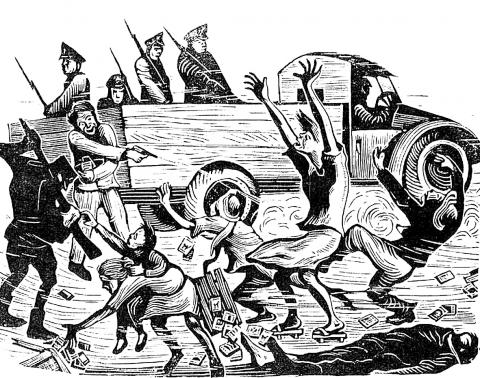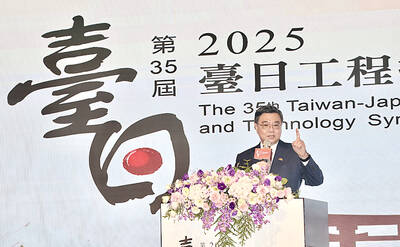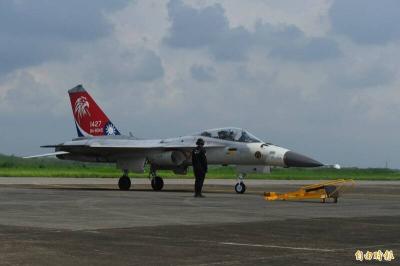The families of nearly 200 people killed in the beginning of the White Terror era have complained that a memorial park in Taipei’s Liuzhangli (六張犁) commemorating the victims of political persecution has fallen into disrepair due to government negligence, an act of neglect they branded as being disrespectful of the dead.
The Park Commemorating Victims of Political Persecution during the Martial Law Period’s (戒嚴時期政治受難者紀念公園) First Cemetery on Chongde Street in the city’s Xinyi District (信義) is covered with leaves and weeds, and strewn with cement bricks. Some of its tombstones have been toppled over, and trash and empty bottles lie strewn everywhere.
The memorial was established in 2003 to honor nearly 200 victims of political persecution between 1949 and 1953. Each tombstone is no bigger than a brick, on which the name of the victim and the date of their death are inscribed.

Photo: Chen Yen-chun, Taipei Times
One of the victims’ family members who complained about the park’s upkeep, a woman surnamed Huang (黃), said a cemetery manager has been put in charge of the facility’s maintenance, but due to its size and a lack of staff, the task of maintaining the park was next to impossible.
She expressed hope that the government would be more attentive to the issue and properly take on the responsibility for the park’s maintenance.
Taipei Mortuary Services Office Director Wu Kun-hong (吳坤宏) said the office outsourced the maintenance of the graveyard to a cleaning company at the beginning of the year, but the contract was terminated due to the company’s financial instability. The government will find a new contractor to take over the task, he added.

Photo: Chen Yen-chun, Taipei Times
Lin Chuan-kai (林傳凱), a researcher who has worked for years on the history of the White Terror era and its victims, said the public sector has taken only nominal care of the memorial park since its establishment, with most of the cleaning being done by the victims’ families and related groups.
However, the topography and relatively soft soil of the First Cemetery site make it necessary for the authorities to carry out any restoration efforts, Lin said.
He suggested that the government better publicize information about the people interred at the cemetery who lost their lives in the White Terror era and produce a visitor’s guide to the monuments to help the public better understand this period in the nation’s history.
Among the many renowned figures honored at the park is Huang Jung-tsan (黃榮燦), who created the now famous printed engraving The Horrifying Inspection (恐怖的檢查) in the aftermath of the 228 Incident.
The 228 Incident refers to the brutal military crackdown launched by the then-Chinese Nationalist Party (KMT) regime against civilian demonstrations in 1947, following an incident in Taipei on Feb. 27.
The event marked the beginning of the White Terror era, in which tens of thousands of Taiwanese were killed, went missing or were imprisoned as the government sought to stamp out dissent and forbade any discussion of the Incident.

LOW RISK: Most nations do not extradite people accused of political crimes, and the UN says extradition can only happen if the act is a crime in both countries, an official said China yesterday issued wanted notices for two Taiwanese influencers, accusing them of committing “separatist acts” by criticizing Beijing, amid broadening concerns over China’s state-directed transnational repression. The Quanzhou Public Security Bureau in a notice posted online said police are offering a reward of up to 25,000 yuan (US$3,523) for information that could contribute to the investigation or apprehension of pro-Taiwanese independence YouTuber Wen Tzu-yu (溫子渝),who is known as Pa Chiung (八炯) online, and rapper Chen Po-yuan (陳柏源). Wen and Chen are suspected of spreading content that supported secession from China, slandered Chinese policies that benefit Taiwanese and discrimination against Chinese spouses of

ALIGNED THINKING: Taiwan and Japan have a mutual interest in trade, culture and engineering, and can work together for stability, Cho Jung-tai said Taiwan and Japan are two like-minded countries willing to work together to form a “safety barrier” in the Indo-Pacific region, Premier Cho Jung-tai (卓榮泰) yesterday said at the opening ceremony of the 35th Taiwan-Japan Modern Engineering and Technology Symposium in Taipei. Taiwan and Japan are close geographically and closer emotionally, he added. Citing the overflowing of a barrier lake in the Mataian River (馬太鞍溪) in September, Cho said the submersible water level sensors given by Japan during the disaster helped Taiwan monitor the lake’s water levels more accurately. Japan also provided a lot of vaccines early in the outbreak of the COVID-19 pandemic,

PROMOTION: Travelers who want a free stopover must book their flights with designated travel agents, such as Lion Travel, Holiday Tours, Cola Tour and Life Tours Air Canada yesterday said it is offering Taiwanese travelers who are headed to North America free stopovers if they transit though airports in Japan and South Korea. The promotion was launched in response to a potential rise in demand for flights to North America in June and July next year, when the US, Canada and Mexico are scheduled to jointly host the FIFA World Cup, Air Canada said. Air Canada offers services to 13 of the 16 host cities of the tournament’s soccer games, including Toronto and Vancouver; Mexico City, Guadalajara and Monterrey in Mexico; Atlanta, Georgia; Boston; Dallas; Houston;

The US approved the possible sale to Taiwan of fighter jet spare and repair parts for US$330 million, the Pentagon said late yesterday, marking the first such potential transaction since US President Donald Trump took office in January. "The proposed sale will improve the recipient's capability to meet current and future threats by maintaining the operational readiness of the recipient's fleet of F-16, C-130," and other aircraft, the Pentagon said in a statement. Trump previously said that Chinese President Xi Jinping (習近平) has told him he would not invade Taiwan while the Republican leader is in office. The announcement of the possible arms